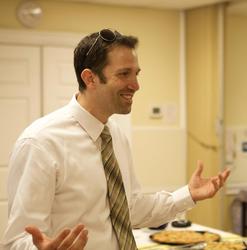When I met up with school psychologists Donna Christy and Robert Hull at the Starbucks in Greenbelt, MD, they sparred good-naturedly about each other’s extra-curricular activities outside the school building—he says she is a big honcho with the National Education Association (NEA) and she says he will speak to any audience, anywhere (as long as his expenses are covered) on the subject of trauma and education. Both work for the Prince George’s (P.G.) County School District in nearby Washington, DC.
They’ve been friends and colleagues for years and share a passion for advancing trauma-informed schools. Christy plans to write her Ph.D. dissertation on the school to prison pipeline. Hull says his special interest is the prison-to-graduation issue. Children who return to school after incarceration aren’t welcomed back with open arms, says Hull, adding to other challenges they face, making graduation even less likely and therefore fueling high recidivism rates.
 Both Christy and Hull played important roles in securing approval of a “Complex Trauma” resolution by the NEA at its annual meeting in July in Washington, DC. Over 7,000 delegates (only a handful are school psychologists) from around the country attend the annual meeting. The 5-sentence resolution (Res. C-8 is attached and online—see page 40) describes the impact on trauma on the brain, how trauma impacts health and impedes access to education, describes the risk of secondary trauma on those who serve children, and recognizes trauma’s impact across society. The final sentence reads “The Association also believes that school districts should provide complex trauma training for education employees, and program to address the effects of trauma.”
Both Christy and Hull played important roles in securing approval of a “Complex Trauma” resolution by the NEA at its annual meeting in July in Washington, DC. Over 7,000 delegates (only a handful are school psychologists) from around the country attend the annual meeting. The 5-sentence resolution (Res. C-8 is attached and online—see page 40) describes the impact on trauma on the brain, how trauma impacts health and impedes access to education, describes the risk of secondary trauma on those who serve children, and recognizes trauma’s impact across society. The final sentence reads “The Association also believes that school districts should provide complex trauma training for education employees, and program to address the effects of trauma.”
The resolution, initiated by an NEA delegate from Washington State, had to clear the NEA Resolutions Committee before going to the delegates for a vote. As a member of the Committee, Christy was on the ground level to move the resolution forward for consideration by the NEA delegates. Because Christy is a school psychologist, fellow committee members sought her expertise to better understand the implications of the resolution. She was able to champion the resolution in the early critical steps toward approval.
 Some of the groundwork was laid for the Resolution back in 2014 when NEA delegates approved a new business item at the annual meeting in Denver that required the organization to publish information on best practices related to students who have experienced domestic violence and sexual victimization. Hull worked with delegates from Alaska to gain approval of the item. Molly Cevasco, Eric Rossen, and Hull developed the resource that was shared with the membership. This resource document is based on a chapter in a book, “Supporting and Educating Traumatized Students,” edited by Rossen and Hull. The two were former colleagues in P.G. County; Rossen is now Director of Professional Development and Standards for the National Association of School Psychologists.
Some of the groundwork was laid for the Resolution back in 2014 when NEA delegates approved a new business item at the annual meeting in Denver that required the organization to publish information on best practices related to students who have experienced domestic violence and sexual victimization. Hull worked with delegates from Alaska to gain approval of the item. Molly Cevasco, Eric Rossen, and Hull developed the resource that was shared with the membership. This resource document is based on a chapter in a book, “Supporting and Educating Traumatized Students,” edited by Rossen and Hull. The two were former colleagues in P.G. County; Rossen is now Director of Professional Development and Standards for the National Association of School Psychologists.
Resolutions are important because all NEA policies, including those reflected in the NEA Legislative Program, must be consistent with approved resolutions and because they are reference points for inquiries about NEA policy by members of the press and Congress. NEA policies must be consistent at all levels—local, state, and national—according to Christy, so the resolution has the potential to be impactful in city councils, state legislatures, Congress and federal agencies.
Paul Birkmeier, staff with NEA’s Center for Governance, explained in email correspondence “NEA resolutions are not action oriented, and they are not specifically funded by NEA.” For the resolution to have an impact, NEA will have to take action to implement it either “through activities in the adopted NEA budget and through interpretation and enunciation of NEA’s commitment to the stated belief by organizational leaders and staff,” according to Birkmeier.
Birkmeir also pointed to other related NEA policy and resources on the topic citing the NEA Policy Statement on Discipline and the School-to-Prison Pipeline (see pages 26-29), adopted by the NEA Representative Assembly. He also provided a link to an article on trauma and children that was also published in the May issue of NEA’s member magazine.
Because NEA is a huge organization—3 million members—and a powerful force in American politics, the passage of this resolution and other NEA activities have the potential to move the issue of trauma-informed schools and related strategies up on NEA’s policy priorities and therefore influence the nation’s domestic policy agenda. Earlier in this presidential election season, Secretary Clinton actively sought and was successful in gaining the support of the NEA political action body. If she is elected, NEA is well positioned to build on a strong relationship with her and to move mutual priorities forward in the next Administration.



Comments (0)